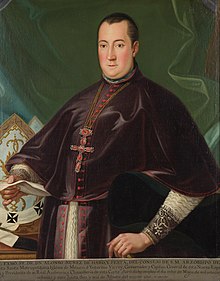Alonso Núñez de Haro y Peralta
|
His Excellency Alonso Núñez de Haro y Peralta |
|
|---|---|
| Archbishop of Mexico | |
 |
|
| See | Mexico |
| Appointed | March 30, 1772 |
| Term ended | May 26, 1800 |
| Predecessor | Francisco Antonio de Lorenzana y Butrón |
| Successor | Francisco Javier de Lizana y Beaumont |
| Orders | |
| Ordination | September 13, 1772 |
| Personal details | |
| Born |
October 31, 1729 Villagarcía del Llano, Cuenca Province, Spain |
| Died | May 26, 1800 (aged 70) Mexico City, New Spain (now Mexico) |
| Nationality | Spanish |
| Denomination | Roman Catholic Church |
| Alma mater |
University of Toledo University of Bologna University of Ávila |
Dr. Alonso Núñez de Haro y Peralta (October 31, 1729, Villagarcía del Llano, Cuenca Province, Spain – May 26, 1800, Mexico City) was archbishop of Mexico from September 12, 1772 to May 26, 1800, and viceroy of New Spain from May 8, 1787 to August 16, 1787.
Núñez de Haro was born in the diocese of Cuenca, Spain, probably on October 31, 1729, although some sources give the date as November 1. He began his studies at the University of Toledo, then received his doctorate from the University of Bologna. Thereafter he became professor at the University of Ávila. He was also a canon in Segovia and Toledo. Studious and intelligent, he learned Latin, Greek, Hebrew, French and Italian.
In 1771 he was named archbishop of Mexico.
As archbishop, he converted the Jesuit colegio of Tepotzotlán into the Seminario de Instrucción, Retiro Voluntario y Corrección, a combined site of instruction for priests, retirement home, and jail for ecclesiastics, since with ecclesiastical privileges (fuero eclesiástico), priests were under the jurisdiction of canonical courts. At the seminary, he committed to studies relevant to Mexico by creating chairs in Mexican, Otomí, and Church history. He advanced the work on the Chapel of Pocito in Guadalupe and on the cathedral in Mexico City. He established a foundling home and a Capuchin convent. He added many books to the library of the archdiocese and ordered scholarships and prizes for distinguished seminary students.
In 1770 Archbishop Núñez de Haro also converted a Jesuit seminary and residence into the Hospital San Andrés. This hospital was modeled on the General Hospital in Madrid and was intended to treat all ailments. In 1788 he added to its functions those of the Hospital Amor de Dios, ("love of God") which was dedicated to the treatment of syphilis. The Hospital San Andrés remained the responsibility of the archdiocese, although it received considerable official support. It eventually had a capacity of 1,000 beds, arranged in 39 wards. In addition, it contained the largest apothecary shop in New Spain, a chandler's shop, a laboratory, and a department for dissections and post mortem examinations. It had the income of 22 urban properties, a share of the tithes, and a monopoly on the game of pelota.
...
Wikipedia
